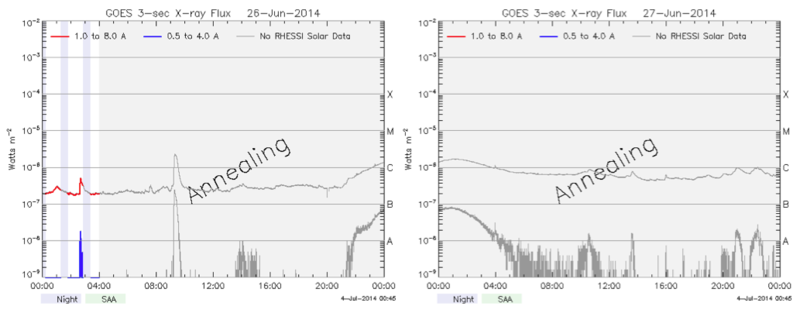Mysteries of Flare/CME Initiation
From RHESSI Wiki
| Nugget | |
|---|---|
| Number: | 228 |
| 1st Author: | Hugh Hudson |
| 2nd Author: | Shaun Bloomfield |
| Published: | May 28, 2014 |
| Next Nugget: | TBD |
| Previous Nugget: | Solar Cosmic Rays, Neutrons, and Fermi Gamma-Rays |
| List all | |
Contents |
Introduction
A recent series of solar [flares] and coronal mass ejections [CMEs] from NOAA active region 12087 (central meridian passage 15 June, 2014) has included three more X-class events and some interesting patterns of behavior that we discuss here. This activity brings the total number of X-class flares to 34 for this cycle.
This flaring activity brings questions about flare/CME initiation. Among these questions we note two particular phenomena: the association of CME eruptions with impulsive flares that distinctly do not fit the pattern of the standard development (see, for example, Nugget 226). These fast events are not "long duration" or "long decay" events (LDEs; see Ref. [1] for a description).
Another curiosity is the apparent doubling-up of energetic events. Normally we think of flare build-up as a gradual process, but this active region once again clearly demonstrated that we can't really be sure about this: the two X-class flares SOL2014-06-10T11 and SOL2014-06-10T12 were only about an hour apart, and within a few Mm of one another.
Figure 1, a standard RHESSI-orbit [GOES] plot from the RHESSI [Browser] illustrates both of these curiosities with the two X-class flares of 10 June. The AIA imagery of these events clearly shows them to orginate close to one another, and both to result in CME eruptions. As the Figure shows, the first event is extremely impulsive and shows no hint of bright arcade development as predicted by the reconnection models; the second event does include an arcade. As Browser further shows, this second event also drove a type II burst and produced gamma-ray emission.
The LDE Myth?
It is certainly well-documented that CMEs and LDEs often go together, and this has been a powerful argument in favor of large-scale reconnection model of flare development. This paradigm is so attractive that there is relatively little theoretical work on flares that are not eruptive, or appear as "failed eruptions" or "simple loop flares." Neither of these would naturally form a large-scale current sheet in which [magnetic reconnection] could return some of the energy involved in the eruption, but of course by far the great majority of flares are not eruptive.
The LDE/CME association has always appeared as a statistical one, and in that sense it may not be surprising that some extreme examples of non-LDE CME events will appear. Anecdotally (since we're unaware of any rigorous analysis on this topic), non-LDE CMEs such as the one in Figure 1 have perhaps appeared more frequently during this activity cycle than in previous ones. This might be expected from the possible environmental influence of the larger-scale corona, even in a global sense, on CME initiation. The currently popular [torus instability] model is an example of a related theory.
Also anecdotally, we think that non-LDE CMEs may appear multiple times from a given active region. In the case of AR 12087, we note not only SOL2010-06-10T11 (Figure 1), but also SOL 2014-06-11T21 (M3.9) in this category; on the other hand the region's other non-LDE X-class flare (SOL2014-11-09 X1.0) was CME-less.
We conclude that the LDE character of a flare neither a necessary nor sufficient condition for CME occurrence, and that there is very likely to be some important physics omitted from models of CME initiation that embrace the idea of large-scale magnetic reconnection and arcade formation.
Nests of Activity and Duplicity
Is the appearance of pairs of flares ("duplicity") physically meaningful? The two X-class flares of June 10, separated by only one hour, were followed on the next day by a similar pair (X and M) and perhaps another pair of M-class events. We have used the RHESSI quick-look flare locations to study these pairs of flares, with the result in Figure 2 suggesting that no, there is no pattern here, or at least none that a cursory glance can detect. Again we are unaware of any rigorous study of the flare ["k-omega diagram"] analogous to the ones that show solar p-mode oscillations so dramatically. But Figure 2 does remind us of the "nests of activity" described in Figure 2: flares do tend to bunch up, which is a manifestation of persistent emergence of new flux in the standard flare build-up scenario. Zwaan summarized this morphology in Ref. [2].

The proximity of the two X-class flares on June 10 raises another interesting simple question. How can a catastrophic event involving the restructuring of the corona of an active region, such as the first flare of this pair, not have destabilized the adjacent part of the region that will flare shortly thereafter? How could it have been nearly ripe for eruption in a state approaching marginal instability, and not been "triggered"?
Conclusions
There are some seldom-mentioned features of flux emergence and CME initiation that AR 12087 illustrates well.
References
[1] "A survey of soft X-ray limb flare images"
[2] "Elements and patterns in the solar magnetic field"
| RHESSI Nugget Date | 28 May 2014 + |
| RHESSI Nugget First Author | Hugh Hudson + |
| RHESSI Nugget Index | 228 + |
| RHESSI Nugget Second Author | Shaun Bloomfield + |
